Teaching Expressive Writing to Students with Learning Disabilities
A recent meta-analysis (Gersten & Baker, 1999) highlights research-based instructional approaches for teaching written expression to students with learning disabilities, including ways to teach students how to analyze material learned in the classroom and how to write personal narratives, persuasive essays, and other genres. All of the instructional interventions studied improved the quality of students’ written products, and there was evidence of positive impact on students’ self-efficacy, i.e., their senses of being able to write.
Expressive writing was defined as writing for the purpose of displaying knowledge or supporting self-expression (Graham & Harris, 1989). This analysis asked, “Given a group of studies designed explicitly for the purpose of improving the writing of students with learning disabilities, which interventions and components were found to be most effective, and what is the strength of their effects?” This definition and research question led the analysis to include studies of a various interventions. Virtually all of the interventions studied were multifaceted. Three components stood out as ones that reliably and consistently led to improved outcomes in teaching expressive writing to students with learning disabilities:

Adhering to a basic framework of planning, writing, and revision
Explicitly teaching critical steps in the writing process, providing feedback guided by the information explicitly taught.
Teaching students to write requires showing them how to develop and organize what they want to say and guiding them in the process of getting it down on paper. Most of the interventions used a basic framework based on planning, writing, and revising. These steps are part of a recursive, rather than linear, process, i.e., each step may be revisited during the writing process, and the steps do not always proceed in the same order. In these studies, each step was taught explicitly, with several examples and often supported by a “think sheet,” a prompt card, or a mnemonic.
- Planning. Well-developed plans for writing result in better first drafts. Teachers or peers who write well can verbalize the process they go through to help students develop their own “plans of action.” One type of plan of action, called a “Planning Think Sheet,” uses a series of sequential, structured prompts. It specifies a topic and asks the questions, “Who (am I writing for)?,” “Why am I writing?,” “What do I know?,” “How can I group my ideas?” and “How will I organize my ideas?” (Englert, Raphael & Anderson, 1992). Another technique is to use semantic mapping to help students plan their writing.
A well-developed plan of action also gives the student and teacher a common language to use in discussing the writing. The dialogue between teacher and student represents a major advance in writing instruction over traditional methods that required students to work in relative isolation.
- Revising and editing. Revising and editing skills are critical to the writing process. Developing methods to help students refine and edit their work has been difficult, but a few researchers have begun to develop specific strategies that appear promising. For example, Wong, Butler, Ficzere, and Kuperis (1996), in teaching students to write opinion essays, used peer editing as an instructional strategy for the students. Pairs of students alternated their roles as student-writer and student-critic. The student-critic identified ambiguities in the essay and asked the writer for clarification. With help from the teacher, the students made revisions. The teacher also provided the student-writer with feedback on clarity and on the cogency of the supportive arguments. Once the clarity and cogency of the essay met the teacher’s standard, the pair moved on to correct capitalization, spelling, and punctuation. Through this process, the student-writer had to explain his or her communicative intent to the peer and revise the essay to faithfully reflect it. These clarifying interactive dialogues led the student-critic and student-writer to understand each other’s perspective. In this way the trainees developed a sense of audience for their writing.
Explicitly teaching text structures provides a guide for the writing task, whether it is a persuasive essay, a personal narrative, or an essay comparing and contrasting two phenomena. Different types of writing are based on different structures. For example, a persuasive essay contains a thesis and supporting arguments, while narrative writing may contain character development and a story climax. Instruction in text structures typically includes numerous explicit models and prompts. Although different writers may proceed with the structures in a different order, good writing involves what Englert & Mariage (1991) called “overlapping and recursive processes.” These processes do not proceed in a particular order, and one process may inform another in such a way that the author returns to previous steps to update or revise on a regular basis. Again, a plan of action is helpful. The plan makes text structures more visible to students and helps to demystify the writing process.
A third component common to these successful interventions was frequent feedback to students on the overall quality of writing, missing elements, and strengths. When feedback is combined with instruction in the writing process, the dialogue between student and teacher is strengthened. Giving and receiving feedback also helps students to develop “reader sensitivity” and their own writing style. Wong et al. (1997) hypothesized that interactive dialogues, which led students through multiple cycles of reflection, realization, and redress of problems, helped students “see” their thoughts and write from another’s perspective. Across the studies of successful writing instruction, teachers and students had an organizational framework and language to use in providing feedback on such aspects of writing as organization, originality, and interpretation. Wong and her colleagues modeled procedures, for students and teachers, providing feedback so that they would attend to the surface features of writing (e.g., spelling and punctuation) as well as to the presentation of ideas.
Specific methods
Numerous methods for teaching written expression incorporate these three common principles. Two examples are Self-Regulated Strategy Development (SRSD) (Graham & Harris, 1989b) and Cognitive Strategy Instruction in Writing (Englert et al., 1995; Englert & Mariage, 1991). The SRSD technique involves self-directed prompts that require the students to (a) consider their audience and reasons for writing, (b) develop a plan for what they intend to say using frames to generate or organize writing notes; (c) evaluate possible content by considering its impact on the reader; and (d) continue the process of content generation and planning during the act of writing. Cognitive Strategy Instruction in Writing includes brainstorming strategies for preparing to write, organizing strategies to relate and categorize the ideas, comprehension strategies as students read and gather information for their writing, and monitoring strategies as they clarify their thoughts and the relationships among their items of information. All of these strategies are applied prior to the actual writing.
Emerging issues in writing instruction for students with learning disabilities
Gersten and Baker (1999) identify some issues in which research is expected to blossom in coming years. The first group of issues concerns the mechanics versus the content of writing. Early evidence suggested that writing instruction that focused more on content would better capitalize on the strengths of students with learning disabilities. When asked to write about complex ideas, students with learning disabilities often showed conceptual performance beyond that which would be expected on the basis of their performance on lower-level skills such as capitalization, punctuation and spelling (Goldman, Hasselbring, & The Cognition Technology Group at Vanderbilt, 1977).
More recent research indicates that dictating to a scribe can eliminate mechanical difficulties and result in a longer, higher-quality composition (e.g., De La Paz & Graham, 1997). While students must eventually learn to do their own writing, these findings suggest a possible bridge to higher performance. Gersten and Baker point out that daily writing instruction should include time devoted to both the mechanics and the process of writing. Problems with the mechanics of writing must be addressed in expressive writing instruction; there is a reciprocal relationship between mastery of transcription skills and growth in the quality of writing. When students have mastered the mechanics, their cognitive resources can be devoted to planning, composing, and revising their work.
According to Gersten and Baker, another issue that is likely to be the focus of expressive writing research is the transfer of writing skills and the spontaneous use of the strategies involved in writing to other subject matter areas to raise the student’s overall level of academic achievement. In the meta-analysis reported here, few investigated the transfer of writing skills. Those that did found mixed results. Wong called for instruction to promote transfer of skill. When students are provided such opportunities, she says, transfer will be greatly enhanced.
Based on Teaching Expressive Writing To Students With Learning Disabilities: A Meta-Analysis by Russell Gersten and Scott Baker, 1999.
Liked it? Share it!
DeLaPaz, S. & Graham, S. (1997). Strategy instruction in planning: Effects on the writing performance and behavior of students with learning difficulties. Exceptional Children, 63(2), 167-181.
Englert, C.S., Garmon, A. Mariage, T. Rozendal, M. Tarrant, K. & Urba, J. (1995). The early literacy project: Connecting across the literacy curriculum. Learning Disability Quarterly, 18,253-275.
Englert, C.S., & Mariage, T. V. (1991). Shared understandings: Structuring the writing experience through dialogue. Journal of Learning Disabilities, 24(6), 330-342.
Englert, C.S., Raphael, T.E., & Anderson, L.M. (1992). Socially mediated instruction: Improving students' knowledge and talk about writing. Elementary School Journal, 92, 411-449.
Gersten, R. & Baker, S. (1999). Teaching expressive writing to students with learning disabilities: a meta-analysis. Eugene, OR: University of Oregon.
Goldman, S.R., Hasselbring, T.S., and The Cognition Technology Group at Vanderbilt (1977). Achieving meaningful mathematics literacy for students with learning disabilities. Journal of Learning Disabilities, 30(2), 198-208.
Graham, S. and Harris, K.R. (1989a). Components analysis of cognitive strategy instruction: Effects on learning disabled students' compositions and self-efficacy. Journal of Educational Psychology, 81, 353-361.
Graham, S. and Harris, K.R. (1989b). Improving learning disabled students' skills at composing essays: Self-instructional strategy training. Exceptional Children, 56 (201-214).
Wong, B.Y.L., Butler, D.L., Ficzere, S.A., & Kuperis, S. (1997). Teaching adolescents with learning disabilities and low achievers to plan, write and revise compare-contrast essays. Learning Disabilities Research and Practice 9(2), 78-90.
Wong, B.Y.L., Butler, D.L. Ficzere, S.A., & Kuperis, S. (1996). Teaching low achievers and students with learning disabilities to plan, write, and revise opinion essays. Journal of Learning Disabilities, 20, 197-212.
Visit our sister websites:
Reading rockets launching young readers (opens in a new window), start with a book read. explore. learn (opens in a new window), colorín colorado helping ells succeed (opens in a new window), adlit all about adolescent literacy (opens in a new window), reading universe all about teaching reading and writing (opens in a new window).
- Skip to Nav
- Skip to Main
- Skip to Footer
The Writing Process Through the Eyes of Children with Special Needs (Part 1)
Please try again

The achievement of students with special needs is a critical issue for all schools and teachers. Writing effectively is one of the areas in which students struggle most and in which classroom teachers struggle most to support them. This is the first in a four part series chronicling my efforts at teaching writing to students with special needs in a world dominated by the Internet and digital media.
Writing is always a process. For some students, it’s an even bigger struggle to know what steps in that process go in what order, or if they are relevant to the big picture at all. Knowing what to write is difficult, and often when given a topic that is not personally interesting, can lead to even bigger problems. In the world of my students, often times, this is the case. I’ve found the pre-writing strategies I discuss here are a good way to begin to overcome some of the inherent challenges students with special needs face.
My background is working with students who have special needs. Many struggle with comprehension and/or writing and are in my Resource English class to help support and build these skills. The class runs just like any other general education English class, but I work with a Special Education background in mind. We read the same books, write the same types of essays, and have the same types of discussions. At my school, the overarching goal we have is Academic Discourse . Through Academic Discourse, all students are expected to respond to text in a thoughtful way. This uses language in ways that better prepares our students for life outside of high school.
The bigger struggle comes when students are expected, after high school, to be able to use technology and to use it properly to achieve specific work-related goals. This becomes a challenge when students are confronted with these high expectations and are also expected to have brilliant writing skills. To prepare them for this eventuality, my goal with my students is to teach them ways to support their learning through writing, by utilizing the online tools that they will eventually need to be successful adults.
In the case of writing, I have a process I use to help support my students with their work. Since my school requires that we follow an Academic Discourse model, my students already have high expectations. With Academic Discourse, not only are students expected to read and write as we have traditionally expected them to, but now they are expected to be heard. No matter if you’re the smartest kid, the shyest kid, it doesn’t matter: your voice will be heard. To ease them into this transition, there are many ways I have implemented modified learning to help support them on this journey.
For example, when beginning an assignment where my students will end up having to write a 5 paragraph essay, I automatically start with a rubric . If you show the students what is required of them, they will better understand the expectations that are part of the process. From there, I move on to the collecting of information. Since most of our assignments stem from articles we read about real-world events, such as those found on KQED’s The Lowdown. The goal is to find something of interest that they will all benefit from exploring. Included with the rubric is the assignment with guiding questions and sentence frames. (Here is a good introduction to using sentence frames to improve language skills.) Most of the students will use these questions and frames to help shape their final essay.
I usually start with a gallery walk. I place large poster paper around the room with the guiding questions, designed to trigger ideas from my students. This is non-confrontational and gets the kids thinking about the topic they will be writing about eventually. During the gallery walk, students have markers and are asked to pick different posters and go around and answer the questions on each poster. If they don’t know what to write, I ask them to write their opinions or questions they have. Each student is required to answer. They do not have to interact, as this is usually a quiet individual activity at first. After, I will have them walk to the poster they find most connected to their opinion or claim they want to focus on. Then they discuss their ideas with other students who have the same agreements. T he posters stay up throughout the writing process. I eventually put these up on our shared space on the internet and keep them there for my students to access.
We then move onto the real nitty-gritty stuff – reading for meaning and understanding. Since this is the time of technology, we often utilize Google Apps for Education to obtain access to these articles. I will post excerpts from articles to my Google Classroom and share them with my students. I always teach my students annotation at the beginning of each year; this way they have a good grasp of how to best understand text. There are a number of programs that you can use. I use Google Docs and upload the text to each of my students so they each have a clean copy. They use highlighting, italicizing, as well as the comment feature to write their annotations. The expectation from annotating is that students write out their ideas, their questions, their understandings or confusions. I want my students to be able to write predictions, and summarize thoughtfully.
Typically we will include 2-3 texts for each essay we write in class. These are articles I find, they are articles my students find, or they are novels we are reading. Then, we find all the pertinent information that they believe is relevant to their final essay. The students seem to enjoy this process because although it’s a lot of work to read through a text and really read it for understanding, I find that they do more work when it’s in the online component than when they hand-wrote their annotations.
At this point my students have gathered several ideas by learning how to follow the online tools provided for them. Students learn to use a rubric as a checklist to know what I am looking for in their work, and students have learned the annotation tools to get them writing out their notes to help them write out thoughtful connections. Stay tuned for part 2, when we discuss using sentence frames and partner/group discussion to better develop student writing ideas.
To learn more about how we use your information, please read our privacy policy.

Disciplinary Approaches to Composing Texts
Writing in Special Education
By professor leanne syring.
Writing in the field of education is essential to share insights and information. A teacher may want to research a topic to teach. The research may include the history of the topic, the current status of the topic, or how to best teach the particular topic. Perhaps you, as a teacher, have taught a lesson or a unit in the area and it worked well. You may write a blog, design a curriculum, or write a journal article on the subject. Sharing knowledge, expertise, and experience aids in the development of others.
Types of writing in Special Education
All types of writing are done in the field of education. There are textbooks to guide teaching such as Harry Wong’s The First Day of School: How to Be an Effective Teacher. There are also specific curriculums' a school may follow, such as Core Knowledge Curriculum by E.D. Hirsch. Books of nonfiction are also included in the field of education as a source of knowledge and enlightenment, such as A Thorn in My Pocket: Temple Grandin’s Mother Tells the Family Story by Eustacia Cutler. Journal articles for research, practical magazines for ideas, blogs, tweets, websites, and Facebook pages, are other varieties of writing in the education field.
The areas that have the most impact on the field on a daily basis are the blogs and social media posts (such as tweets) that share instantaneous information. A writer than can convey a message succinctly and with high interest can spread information more quickly and across a broader audience than research journals. However, the research being done in education is important in advancing the field, formulating new ideas and proving or disproving the worth of the idea.
Writing in the Special Education classroom
Students in the education classrooms write essays, research articles, policy papers, and teaching assessments. A variety of writing styles is required. These skills transfer outside of the university experience for teachers as they assess their students, write articles for school news, correspond with parents, research topics, and advocate for their students or school. Funding for schools is also an issue at times and the ability to write grant proposals is also a sought after skill.
Tips for writing well in Special Education
Key markers in the field of educational writing include a succinct, yet descriptive title. Also, citation of sources and adherence to the formatting that is included in APA. A paper that is formatted correctly is instantly recognizable. It is important to use the APA manual when writing.
View a video on Writing in Special Education.
Special Education: Disciplinary Perspective
Reading in Special Education
Research in Special Education
Documentation in Special Education
- Introduction to the Text
- Writing is Important in your Major
- Advice from Students
- Making Your Writing Work: Ethos & Commonplaces
- Professional Associations
- Scholarship as Conversation
- Genres and Finding Sources
- Genres, Metagenres, and the Rhetorical Situation
- Analyzing Scholarly, Trade, and Popular Sources
- Library Research Overview
- Introduction To Research
- Research Process
- Choosing a Topic
- Determining Genres
- Trouble Finding Sources
- Videos Overview
- Special Education
- Annotated Writing Samples
- Agricultural Education Overview
- Documentation
- Scholarly Writing Sample
- Business Administration Overview
- Communication Studies Overview
- Student Writing Sample
- Computer Science Overview
- Education Overview
- Environmental Science Overview
- Exercise Science Overview
- History Overview
- Justice Administration Overview
- Literary Studies Overview
- Marketing Overview
- Math Overview
- Nursing Overview
- Philosophy Overview
- Professional Writing and Communication Overview
- Videos (English)
- Social Work Overview
- Special Education Overview
NASET.org Home Page
Exceptional teachers teaching exceptional children.
- Overview of NASET
- NASET Leadership
- Directors' Message
- Books by the Executive Directors
- Mission Statement
- NASET Apps for iPhone and iPad
- NASET Store
- NASET Sponsors
- Marketing Opportunities
- Contact NASET
- Renew Your Membership
- Membership Benefits
- Frequently Asked Questions
- Membership Categories
- School / District Membership Information
- Gift Membership
- Membership Benefit for Professors Only
- NASET's Privacy Policy
- Forgot Your User Name or Password?
- Contact Membership Department
- Resources for Special Education Teachers
- Advocacy (Board Certification for Advocacy in Special Education) BCASE
- Board Certification in Special Education
- Inclusion - Board Certification in Inclusion in Special Education (BCISE) Program
- Paraprofessional Skills Preparation Program - PSPP
- Professional Development Program (PDP) Free to NASET Members
- Courses - Professional Development Courses (Free With Membership)
- Forms, Tables, Checklists, and Procedures for Special Education Teachers
- Video and Power Point Library
- IEP Development
- Exceptional Students and Disability Information
- Special Education and the Law
- Transition Services
- Literacy - Teaching Literacy in English to K-5 English Learners
- Facebook - Special Education Teacher Group
- NASET Sponsor's Products and Services
- ADHD Series
- Assessment in Special Education Series
- Autism Spectrum Disorders Series
- Back to School - Special Review
- Bullying of Children
- Classroom Management Series
- Diagnosis of Students with Disabilities and Disorders Series
- Treatment of Disabilities and Disorders for Students Receiving Special Education and Related Services
- Discipline of Students in Special Education Series
- Early Intervention Series
- Genetics in Special Education Series
- How To Series
- Inclusion Series
- IEP Components
- JAASEP - Research Based Journal in Special Education
- Lesser Known Disorders
- NASET NEWS ALERTS
- NASET Q & A Corner
- Parent Teacher Conference Handouts
- The Practical Teacher
- Resolving Disputes with Parents Series
- RTI Roundtable
- Severe Disabilities Series
- Special Educator e-Journal - Latest and Archived Issues
- Week in Review
- Working with Paraprofessionals in Your School
- Author Guidelines for Submission of Manuscripts & Articles to NASET
- SCHOOLS of EXCELLENCE
- Exceptional Charter School in Special Education
- Outstanding Special Education Teacher Award
- Board Certification Programs
- Employers - Job Posting Information
- Latest Job Listings
- Professional Development Program (PDP)
- Employers-Post a Job on NASET
- PDP - Professional Development Courses
- Board Certification in Special Education (BCSE)
- Board Certification in IEP Development (BCIEP)
- NASET Continuing Education/Professional Development Courses
- HONOR SOCIETY - Omega Gamma Chi
- Other Resources for Special Education Teaching Positions
- Highly Qualified Teachers
- Special Education Career Advice
- Special Education Career Fact Sheets
- FAQs for Special Education Teachers
- Special Education Teacher Salaries by State
- State Licensure for Special Education Teachers
- Integrated Writing Instruction
Introduction
Students with writing disabilities typically find the act of writing to be both difficult and unrewarding. These students' resulting lack of motivation to write can lock them into a downward spiral, in which they avoid most writing tasks and fail to develop those writing skills in which they are deficient. Indeed, for some students, a diagnosed writing disability may not be neurologically based but instead can be explained by the student's simple lack of opportunities to practice and build competent writing skills.
This issue of The Practical Teacher provides an integrated approach to classroom writing instruction designed to accommodate the special needs of disabled writers, as well as those of their non-disabled peers.
NASET Members may access this Practical Teacher by Logging in (see Login area to the right). Visitors can access a sample issue by Clicking Here
Publications
- What Happens When Children Who Do Not Respond to or Struggle Greatly with Phonics, More of the Same?
- Combining Phonics and Whole Language for Reading Instruction
- Utilizing the Math Routine, “Would You Rather,” to Support Meaningful Classroom Interaction for ALL Students
- Teaching Self-Advocacy Skills to Students with Autism and Other Disabilities
- How Rhyming and Rappin’ Can Improve Reading and Writing: Improving Poetic Intelligence
- U.S. Department of Education Releases New Resource on Supporting Child and Student Social, Emotional, Behavioral and Mental Health during COVID-19 Era
- How Spelling Can Help Reading Learning Common Core Words Quickly and Easily
- Special Advice for Special Educators
- An Alignment of Interactive Notebooks with the Principles of Universal Design
- Comparing and Contrasting Research-to-Teaching Practices: A Critical Analysis of Highly Restrictive Special Education Placements for Students with Low-Incidence Disabilities
- Parental Involvement within Culturally and Linguistically Diverse Families: Misconceptions, Barriers, and Implications
- The Effects of Parent Therapy for Disruptive Behaviors: A Review of the Literature
- Children’s Literature + DI + UDL + Mathematics = Success for Students with Disabilities
- Positive Student-Teacher Relationships: An In-Depth Look into a Behavior Program and its Implications for Teachers of Students with EBD
- A Classroom Without Walls: A New Method for Teaching Life Skills
- 7 Things Secondary Special Education Teachers Need to Know Concerning Career Technical Education
- Understanding and Achieving Collaboration in Special Education*
- Intervention for Struggling Writers in Elementary School: A Review of the Literature
- Fire Safety: How to Teach An Essential Life Skill
- Reciprocal Peer Tutoring: A Review of the Literature
- A Collaborative Approach to Managing Challenging Behaviors of Students with Disabilities: A Review of Literature
- Students with Disabilities in Postsecondary Institutions: What Higher Education Should Be Doing to Support Them
- Hospitality in an Inclusive Classroom
- UDL and Art Education for Students with Disabilities and Physical Impairments
- Truly Experiencing Teaching and Learning for the First Time: Snails are Introduced to a Community of Learners Patricia Mason, Ed.D.
- Disproportionate Representation of English Language Learners (ELLs) in Special Education Programs
- 1+1= iPad Math Apps for Teachers
- Using Music to Teach Reading to Kindergarten Students
- Creating a Classroom for Diverse Learners
- The Challenges of Special Education for Parents and Students: A Literature Review By Reshma Mulchan
- Transitioning From School to the Workplace for Students with Disabilities By: Dr. Faye J. Jones
- Practical Social Skills for Special Education Students
- Effective Communication for Students with Hearing, Vision, or Speech Disabilities in Public Elementary and Secondary Schools
- Educational Services for Immigrant Children and Those Recently Arrived to the United States
- Resources within the Medical and Health Care Community
- Inquiry - Based Learning: Special Education Applications By Jillian F. Swanson
- Intensifying Intervention By Peter Dragula, M.Ed., Doctoral Candidate Capella University
- Special Education Research: Where to Start?
- Intellectual Disabilities in Your Classroom: 9 Tips for Teachers
- Common Core State Standards - Overview
- Multiple Disabilities in Your Classroom: 10 Tips for Teachers
- Supports, Modifications, and Accommodations for Students with Disabilities
- The Five Secrets to Being a Special Education Teacher and Still Loving Your Job
- Bridging the Great Divide: Best Practice Ideas for the Resource/Inclusion Teacher
- Enjoying Favorite Books with Struggling Readers: Part 2
- Trauma Informed Teaching in Special Education By: Joshua A. Del Viscovo, M.S., B.C.S.E.
- Enjoying Favorite Books with Struggling Readers: Part I
- A Proper Fraction Museum
- A Review of Financial Literacy Programs for K-12 Students with Intellectual Disabilities: Utilizing the Principles of Universal Design for Learning
- Winnowing the Internet: Websites for Teachers of Students with Moderate to Severe Disabilities
- Students Who Have Difficulty Learning to Read with Phonics
- Positive Communication Strategies for Collaborating with Parents of Students with Disabilities
- Five Aspects of Teacher influence on Student Behavior
- Teaching Students with Emotional and Behavioral Disabilities (EBD)
- A Primer on Behavior Management
- Is There Only One Way to Teach Reading? Learning to Read in a Different Way
- Anxiety Disorders by Robin Naope Student at Chaminade University Hawaii
- Schedule A Hiring Authority: Tips for Youth and Young Adults with Disabilties Interested in Starting a Career with the Federal Government
- Trusting Information Resources
- College Planning for the Child with Special Needs: A Parent and Teacher Collaboration
- Latin and Greek Word Root Study to Accelerate Spelling, Vocabulary, and Reading Proficiency for All Students
- Dignity, Function, & Choice: Ethical and Practical Considerations on Best Practices for Education Learners with Developmental Delays
- Peer Tutoring: A Strategy to Help Students with Learning Disabilities
- Henrietta's Workshop
- Mental Health Resources
- Centers for Literacy in a Multi-Level Special Education Classroom
- Rapid Reading Cards
- Science Brain Efficient Word Lists
- Brain Efficient Word Lists for Word Sorts, Puzzles, and More
- Plain Language Writing
- Teaching to the Students' Abilities
- World History Brain Efficient Word Lists for Word Sorts, Puzzles, and More
- Tips for Calling on Students in Class
- Tips for Building a Course Website
- The Fourth Grade Slump
- The Brain, Prosody, and Reading Fluency
- Games, Contests & Puzzles: Entertaining Ideas for Educating Students
- A Reading Strategy for Content-Area Teachers
- Using Pen Pal Writing to Improve Writing Skills and Classroom Behavior
- Trouble-Shooting Reward Programs: A Teacher's Guide
- Transforming Schools from Bully-Havens to Safe Havens
- Best Practices in Mathematics
- School-Wide Strategies for Managing Reading
- Applied Math Problems
- Breaking the Attention-Seeking Habit: The Power of Random Positive Teacher Attention
- The Good Behavior Game
- Victims: Preventing Students From Becoming 'Bully-Targets'
- Math Problem-Solving: Combining Cognitive & Metacognitive Strategies in a 7-Step Process
- Bullies: Turning Around Negative Behaviors
- Creating Reward Menus That Motivate
- Points for Grumpy
- Bystanders: Turning Onlookers into Bully-Prevention Agents
- Finding the Spark: More Tips for Building Student Motivation
- Encouraging Student Academic Motivation
- Teacher Behavioral Strategies: A Menu
- Establishing a Positive Classroom Climate: Teacher Advice
- Talk Ticket
- Positive Peer Reports
- Preventing Graffiti and Vandalism
- School-Wide Strategies for Managing Mathematics
- What Every Teacher Should Know About Punishment Techniques and Student Behavior Plans
- Strategies for Working With Emotionally Unpredictable Students
- Managing Test Anxiety
- Entertaining Ideas for Educating Students
- Working With Defiant Kids
- Breaking the Attention-Seeking Habit
- Guided Notes
- Reducing Problem Behaviors Through Good Academic Management
- Creating Safe Playgrounds: A Whole-School Approach
- Paired Reading
- Strategies for Managing Defiance and Non-Compliance
- Extending Learning Across Time & Space
- Forced-Choice Reinforcer Assessment: Guidelines
- Response Effort
- Smooth Classroom Traffic
- Strategies to Prepare Classrooms for Substitute Teachers
- Effective Teacher Commands
- Respectful Classroom
- Establishing a Positive Classroom Climate
- What Teachers Need to Know About Annual & Triennial Reviews
- Training and Working with your Assistant Teachers and Paraprofessionals
- Error Correction & Word Drill Techniques
- Tools to Build Student Text and Lecture Comprehension
- Study Skills Package
- Homework Contracts
- Classwork & Homework
- Finding the Spark: Tips for Building Student Motivation
- Dodging the Power-Struggle Trap
- Introducing Academic Strategies to Students
- Group-Response Techniques
- School-Wide Strategies for Managing - HYPERACTIVITY
- School-Wide Strategies for Managing.......BUS CONDUCT
- Behavioral Contracts
- Determining Measurable Annual Goals in an IEP
- Parent Teacher Conference - 10 Strategies
- Behavioral Interventions - ADHD Students
- Understanding Extended School Year Services
- Accommodating All Students: 'Classic' Ideas That Teachers Can Use to Diversify Classroom Instruction
- School-Wide Strategies for Managing OFF-TASK / INATTENTION
©2024 National Association of Special Education Teachers. All rights reserved

1 (844) 773-3822
Creative Writing Activities for a Special Needs Student
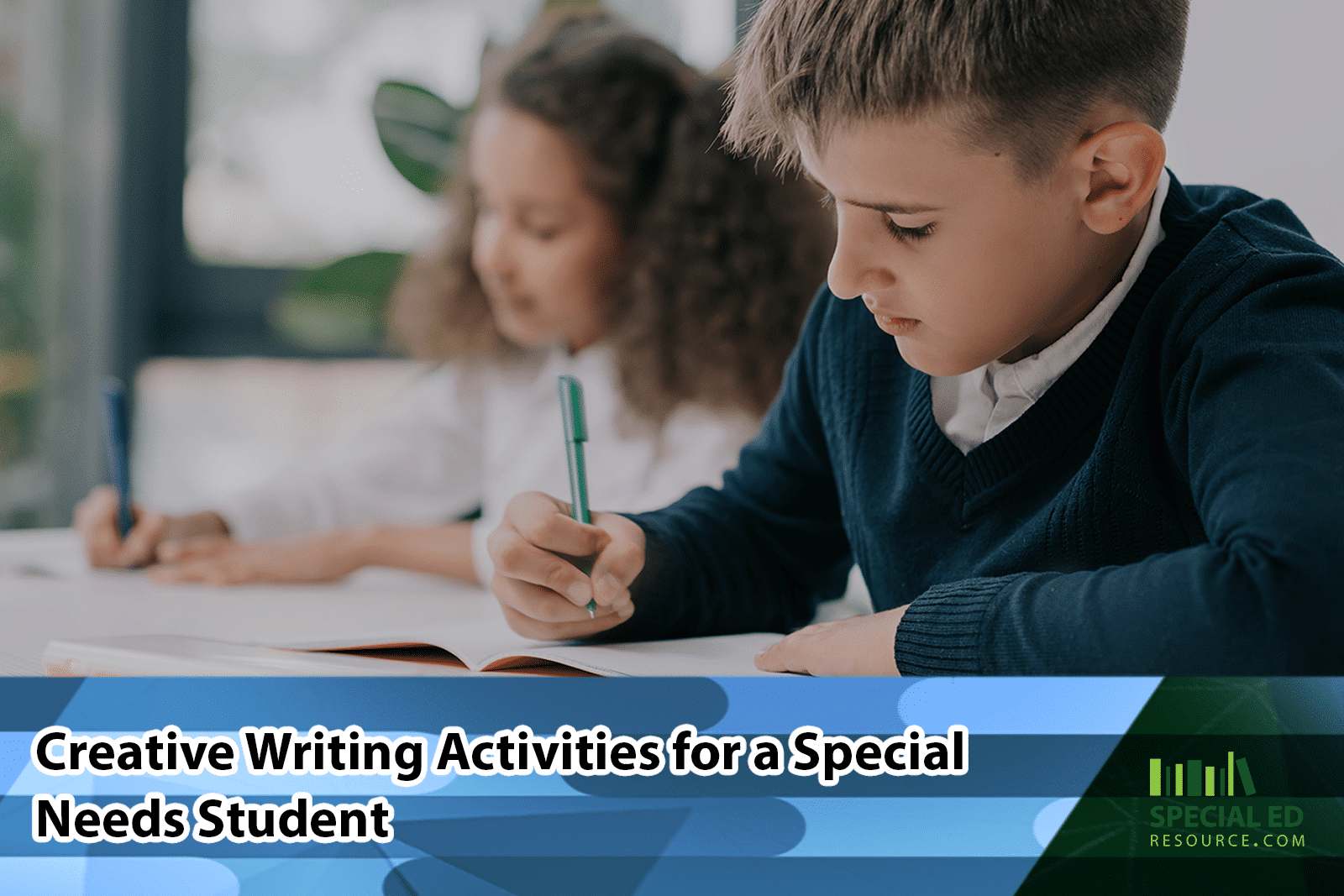
I always assigned creative writing activities on the first day of school to start the year off on the right foot. For instance, I wanted the students to share something from their Summer vacation right after lunch this particular school year.
However, one of my students had a hard time with the assignment.
“I can’t do this!” John said, slamming his pencil down. “These writing assignments are just too hard for me,” he continued.
“What is it about the assignment that makes it too hard for you, John,” I said.
“I’m just not good at writing, and I don’t know what to write about,” John said.
Writing is one of the hardest tasks for children who have special needs. The process of getting their thoughts and ideas down on paper is overwhelming for students.
Creative Writing Activities for a Special Needs Student
Although writing can be a tedious process, there are many different ways for students to express themselves through writing. Here are eleven great writing activities to try with your students.
Want One-On-One Expert Help?!
Check this out.
11 Writing Activities Your Special Needs Students Will Enjoy
#1 comic book writing.
I have found that some of my students love writing comic book stories. They don’t feel overwhelmed like they do when they are assigned a five-paragraph essay. In addition, it is a creative way to practice writing in smaller sentences.
You can find comic book-creating websites or templates online to help you plan the assignment. I have found that Make Beliefs Comix is a great online resource for those wanting to explore and write creatively. I have a student who uses this website, and he loves being able to create his own comic book.
#2 Sensory Writing
Sensory writing is an engaging way to encourage students to use all of their senses in their writing.
Begin by offering your students a variety of sensory experiences, such as:
- Smelling different scents
- Touching various textures
- Listening to different sounds
- Looking at things in different ways, like under a microscope, magnifying glass, or in the dark with a flashlight
Then, have them describe these experiences using vivid language and detail. Sensory writing activities help students to develop their descriptive writing skills and connect their experiences to their writing.
#3 Memory Writing
Memory writing is an activity where students can reflect on something they read earlier in the week. The reading could be something that they read or experienced in reading groups.
The students have a time limit to reflect and write so that everyone has an opportunity to write about what they remember. This creative writing activity is important because it encourages students to recall their memories, which builds stronger connections in the brain.
#4 Reading Response Journals
As a student, I hated work that seemed like a waste of time. One thing that I remember was that each week we had to write a reading response about something that we had read that week.
A reading response journal is a series of entries from students’ reflections, opinions, and reactions to readings. This active learning technique encourages them to examine things thoroughly and relate what they’ve read to their prior knowledge and experiences.
Tips for Reading Response Journals
- Let your student know this is his journal. No one else has to read it, and he will not be graded on what he writes in it.
- Give ample time for each student to write in their journal immediately after reading time when it is fresh on their mind.
- Provide journal prompts so your students aren’t sitting there staring at the blank page, overwhelmed with what to write. Here are a couple of reading response journal prompts:
- Reader Response Journal Prompts
- Reader Response Journal Questions
#5 Picture Storytelling
Visual aids can be a powerful tool to engage special needs students in creative writing. Provide your students with a selection of interesting images, such as landscapes, animals, or scenes from everyday life.
Encourage them to choose one image and write a short story based on what they see. This activity allows students to practice their descriptive writing skills while simultaneously stimulating their imagination.
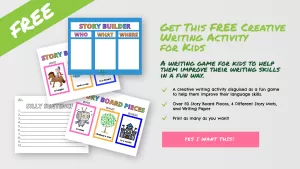
#6 Group Storytelling
Group storytelling is a collaborative and interactive way to help your students practice their writing skills.
First, divide your students into small groups and give each group a story prompt or a sentence to start with. Then, have each student take turns adding a sentence or two to the story.
This activity helps students learn to work together, practice writing coherent narratives, and develop their listening skills.
#7 Sentence Structure Writing Activities
There are many ways to practice writing skills. However, as a teacher, I always think of ways to get my students to work on their sentence structure that is not so boring or overwhelming.
Ideas for Practicing Sentence Structure
- Give them a topic that they have to write about in under 100 words.
- Provide them one word to write a paragraph about what they know about that word.
- Give them unique writing prompts that could have fun and creative endings. For example, “If they were to have a dinosaur for a pet, what would they do with their dinosaur?”
- Have them map out an outline of their paper using a specific topic.
- Do a brainstorming activity using their research topic.
#8 Mad Libs
Mad Libs is an activity that helps students practice their grammar and vocabulary skills in a fun way without pressure.
Create a simple story template with blanks for various parts of speech (nouns, verbs, adjectives, etc.). Have your students fill in the blanks with their own choices of words.
When they’re done, read the completed Mad Libs story aloud, and enjoy the silly and creative results!
#9 Letter Writing
Letter writing can be an enjoyable way for students to practice their writing and communication skills. Encourage students to write letters to friends, family members, or even fictional characters.
Teach them about the different parts of a letter, such as the greeting, body, and closing. Letter writing helps students practice organizing their thoughts, expressing their feelings, and writing in a clear and structured manner.
You can even check out these pen pal programs for kids to write to astronauts, authors, and deployed soldiers.
#10 What If” Scenarios
Encourage your special needs students to think outside the box by presenting them with “what if” scenarios. Provide prompts that ask students to imagine alternate realities or situations, such as “What if…”
You could become invisible for a day?
The world was made of candy, you discovered a secret door in your house that led to a magical land, technology suddenly ceased to exist, everyone had the power to fly, you could communicate with animals, there was a potion that could grant any three wishes, humans could breathe underwater, time could be paused for an hour each day, you found a map to a hidden treasure.
Have your students write a short story or paragraph describing the scenario and its consequences. This activity fosters creativity and helps students explore new perspectives and ideas in their writing.
You could make this a What if Wednesday activity that your students would look forward to each week.
#11 Rewrite
Lastly, another creative writing activity that is fun and gets children to think creatively is something I call “rewrite.”
Many stories over the years have been rewritten with new endings. For example, Cinderella is a story that has multiple different endings.
Give students a short story to rewrite that would change the story in some way. This assignment can be an excellent writing activity to teach them about plagiarism. In addition, you can instruct them on the best way to write the story without copying the author’s ideas or information.
What Creative Writing Activities Do You Use In Your Classroom?
Writing can be difficult for special needs students. However, creative writing activities can be a fun way for students to learn the basics of writing. Choose from any one of these five writing exercises, or try them all!
No matter which you choose, we’re confident that they will help your student develop their language skills in ways that are both enjoyable and challenging.
Do you have an idea for another creative exercise or activity not listed here? Drop it in the comments below so we can add it to our list. We look forward to hearing how this helps your students!
Additional Resources
- Writing Strategies Made Simple
- How to Easily Create Social Stories to Successfully Teach Children
- Reading And Writing Our Way Through Thanksgiving
Get weekly tips and techniques from a fellow Special Educator and parent of a special needs child.
Do you have a student that needs one-on-one special education tutoring that can be done from anywhere? Our special education experts conduct their sessions online! Get them started with a free consultation !
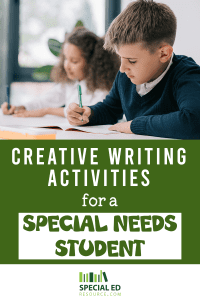
Shannah Holt
Leave a reply cancel reply.
Your email address will not be published. Required fields are marked *
Name *
Email *
Add Comment *
Save my name, email, and website in this browser for the next time I comment.
Post Comment

Our Services
- Special Education Tutoring
- IEP Consulting
- Special Needs Advocacy
- Home Schooling

Popular Articles
7 step iep process.
- Creative Writing Activities
- Activities to Help Kids Focus
- Self-Contained Classroom Defined
- 10 Benefits of Special Needs Tutoring
- 38 Fun Auditory Processing Exercises for Children
- Signs of Auditory Processing Disorder in Children
- Ultimate Guide To Homeschool Organization For Beginners
- How to Set Social Media Boundaries for Kids and Teens
- Simple Ways to Celebrate Earth Day (Fun Family Activities)
- What is a Language Based Learning Disability (Simplified)
Think Differently About Education. We Believe…

We assess your child’s learning style, personality, and interests to pair them with the ideal special ed tutor based on their individual needs.

Through technology and one on one learning, their future path to success can be made clear again.
Are you ready to see confident progress in your child?
Get started with a no-obligation consultation today!

There are hundreds of resources found on our website, SpecialEdResource.com, and on our YouTube channel that were created to help parents JUST LIKE YOU understand the cryptic language of special education.
Important Links
Copyright © 2024 SpecialEd Resource – Design by DeskTeam36 0
- Terms & Conditions
- Privacy Policy

Implementation | Recommended Reading
Writing Instruction for Special Needs Students
Read Time 2 mins | Mar 26, 2020 9:49:59 AM | Written by: Toolbox

Download the research report below
We all know that one effective strategy is to break down a task into smaller, more manageable tasks. Teachers often segment a five paragraph essay, by asking students to ‘just write the introduction.’ But it’s the word ‘just’ that’s almost laughable. (In fact, do you ever notice how anytime the word ‘just’ precedes a task, it’s usually in attempt to make a difficult process appear easy?) “Just writing” an introduction can be so overwhelming and anxiety-producing for a special ed student that they simply shut down. The question becomes HOW to teach these skills.
Research has shown that focusing on the discrete skills and aspects of the writing process produces higher student achievement and success rates than writing taught with a holistic focus on product. When not overwhelmed with having to ‘fill’ an entire page of lined paper, special needs students, after direct instruction that includes teacher modeling and guided practice, can celebrate being successful at writing an interesting beginning for a story, or writing an enticing lead for an expository piece. A segment of elaborative detail, or of suspense. Small successes along the way encourage them and build confidence.

7 Steps to Teaching Writing Skills to Students with Disabilities
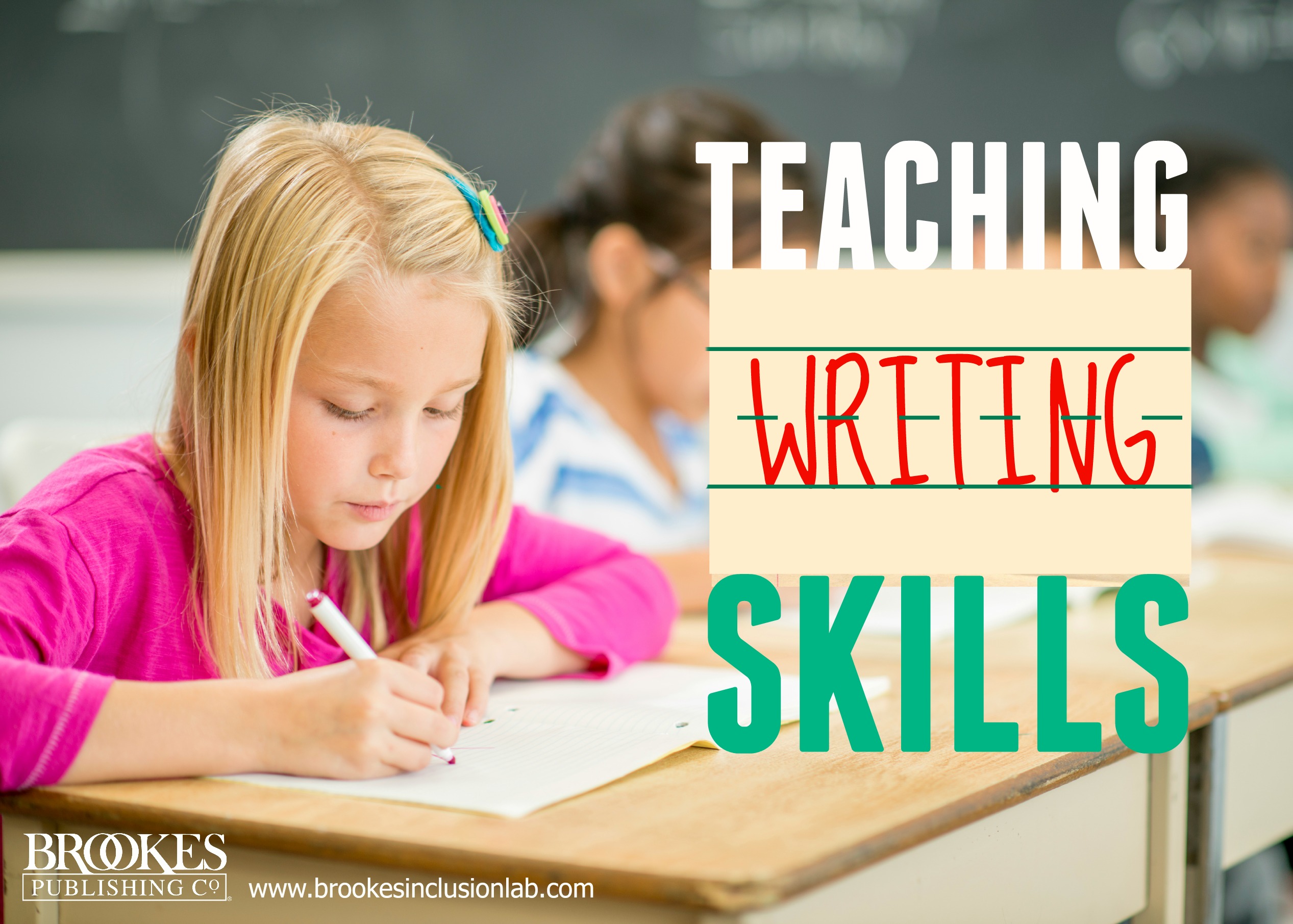
Written expression is a huge part of life inside and outside the classroom. When students with disabilities learn to write, type, and/or select appropriate communicative responses, it opens the door to greater opportunities to reach their learning goals, communicate their preferences, and establish rapport with the people around them.
Today’s post shares 7 important steps to consider when designing programs for teaching written expression to students with disabilities. These are excerpted and adapted from the excellent guidebook More Language Arts, Math, and Science for Students with Severe Disabilities, edited by Diane M. Browder and Fred Spooner.

Assess Students’ Current Repertoire

Which words and communicative responses does the student already use? Before you select a student’s instructional targets, start by determining his or her current writing and communication repertoires through formal and standardized assessments. An assessment of communicative functioning should target:
- Speaker skills, or expressive skills: communication skills that affect the behaviors of others
- Listener skills, or receptive skills: communication skills that involve responding to the words of others
To help you easily determine instruction objectives, you might also use a curriculum-based assessment tool that uncovers information about a broad array of skills relevant to writing, such as a student’s fine motor skills, communication, visual discrimination, and imitation.
Make Writing Meaningful

- Ask what’s important and potentially reinforcing to students, and use the answers as engaging topics for written narratives. Try presenting pictures of characters from a book and asking the student, “Whom would you like to write about?” Let the student select their three most preferred characters to focus on during writing instruction.
- Teach students to request desired objects by exchanging pre-written words for preferred items. For example, you might instruct a student to get a cookie by handing the written word cookie to a partner. Once the student masters this, he or she can be taught to combine the written words big and cookie to communicate a desire for a larger cookie. This is a powerful way to give students direct control over their environment as they learn the functional use of written words. As a bonus, it allows students to use pre-written words without having to learn more complex fine motor and cognitive skills first.
- Deliver reinforcement right away. When your student displays any type of writing or prewriting behavior—holding a crayon, scribbling, pressing keys on a computer, drawing on a SMART Board—follow it up with immediate praise and reinforcement. This will hopefully increase the frequency of their writing behavior and improve the fine motor skills they need for handwriting or keyboarding.
Encourage Imitation

When learning to copy words, some students may need assistive technology to circumvent weaknesses in fine motor skills. You may need to use adapted keyboards (alphabetical, onehanded, large print), AAC selection displays, and/or scanning technology for students who have physical disabilities that affect their gross and fine motor functioning.
Teach Spelling Skills

- Backward chaining strategy. Present the spoken word and then provide a written model for the student to trace. Fade the written model by incrementally removing the letters in the word from the last letter to the first.
- Computer-assisted instruction. Show the student a word/picture combination, and then ask him to select letters from a computer-based array to construct the word shown.
- Cover, copy, compare (CCC) technique. Give the student a piece of paper divided into four columns. The first column contains the targeted spelling word. The student copies the word and writes it in the second column. Then the student folds the first column on the left toward the center (covering the second column) and writes the word from memory in the third column. The student unfolds the paper and compares, and if she’s made an error, she copies the word three times in the final column.
- Video models. Record a video of yourself writing new words on a chalkboard, and display the video on a computer while students type or write the words. Insert a pause in the video to allow the student time to copy the word. Then insert a blank screen, during which the student writes the word from memory, and show the original model once more. (Share the videos with parents to help them support their child in practicing writing skills outside the classroom.)
Encourage Sentence Construction
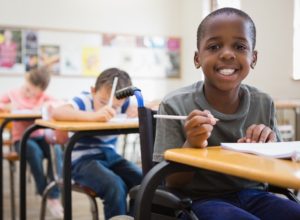
- Once students have acquired a small word-to-picture repertoire of about 50 words, start using sentence starters (“I see a _____,” “The boy is ______”) to expand the length of these responses.
- Fade the sentence starters gradually so that students are independently constructing sentences.
- Once students can write a single sentence about a picture, encourage them to write multiple sentences about a picture. Present pictures containing a variety of stimuli and highlight features of the picture to help students identify content in which to describe or label. These prompts can then be faded to ensure students can choose to write about the stimuli that they deem important.
- Fade the use of pictures so that students can eventually write about things they have learned. Slowly increase the amount of time between the observation of the picture and the writing response. This fading is important, since students will rarely be asked to write about things immediately present in their environment.
Note: If students have not acquired sufficient spelling skills to write sentences, then they may require the use of selection-based writing software in which words or combinations of words are presented within arrays on a computer screen.
Teach Narrative Writing

- Begin by teaching students to write simple paragraphs. Show them that a paragraph names a topic and then tells more about that topic.
- Teach students to apply this rule when writing a paragraph about a picture. Help the student to identify the content of a topic sentence by highlighting a key element within the picture.
- Present a visual organizer and show the student how to use it during planning and while writing his or her paragraphs.
- To give students a model for simple storytelling, show them a series of pictured events or video recordings of real-life events (e.g., child plays ball, child falls down, child cries). You might also give students a series of pictures to sequence themselves before they write a story.
- Once students can write or construct a paragraph about a picture or other visual aid, fade the use of visual supports.
Provide Editing and Revision Instruction
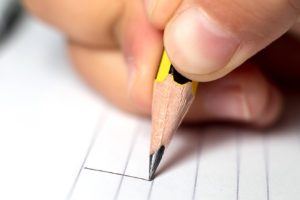
- After teaching a student to write simple sentences, instruct the student to identify whether he or she has included both a person or a thing and something more about the subject.
- Direct the student to look for ending punctuation.
- Ask students to identify missing elements in their stories. Have them practice by presenting a variety of examples and having the student record the presence or absence of the elements.
- Teach students to use checklists to increase the inclusion of critical elements during writing activities.
- Show students how to graph their use of writing elements and monitor their own progress, so they can become more independent and effective writers.
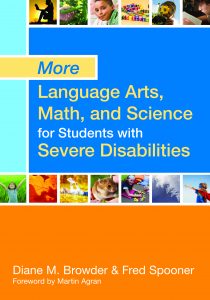
KEEP READING
16 literacy supports for students with special needs, literacy-rich preschool environments for all learners, stay up to date on the latest posts, news, strategies, and more.
- Communication & Language
- Disabilities
- Reading and Literacy
- Special Education
More posts like this
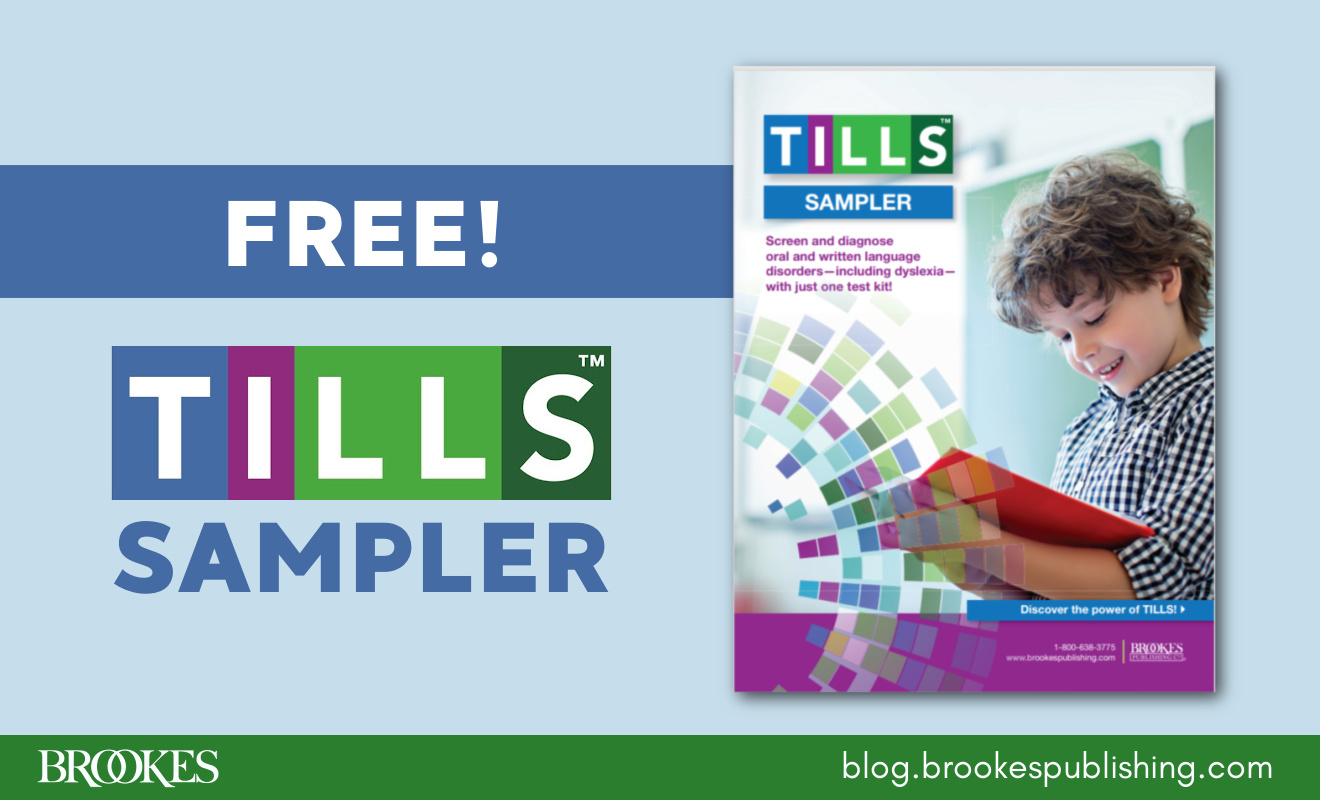
FREE DOWNLOAD: Updated TILLS Sampler
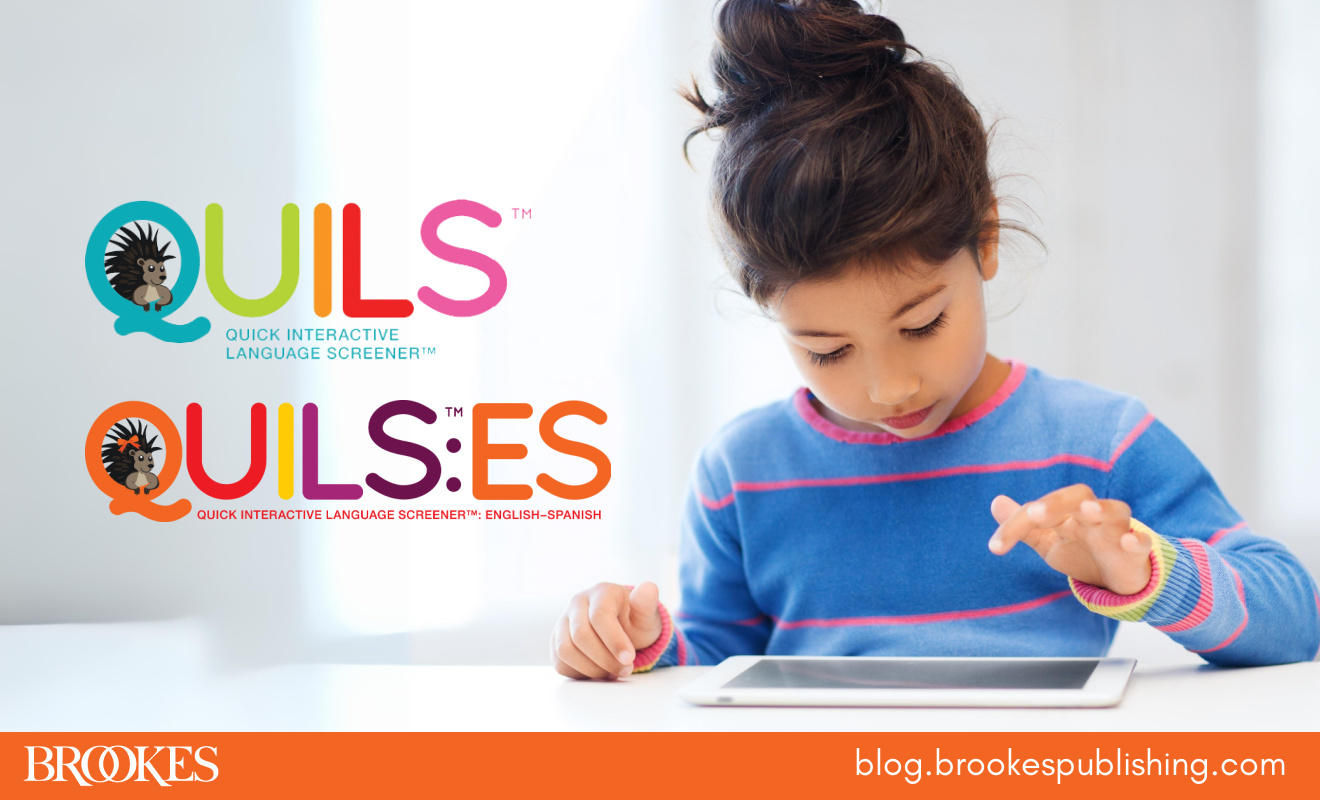
QUILS and QUILS: ES: Your Key to Catching Language Delays Early
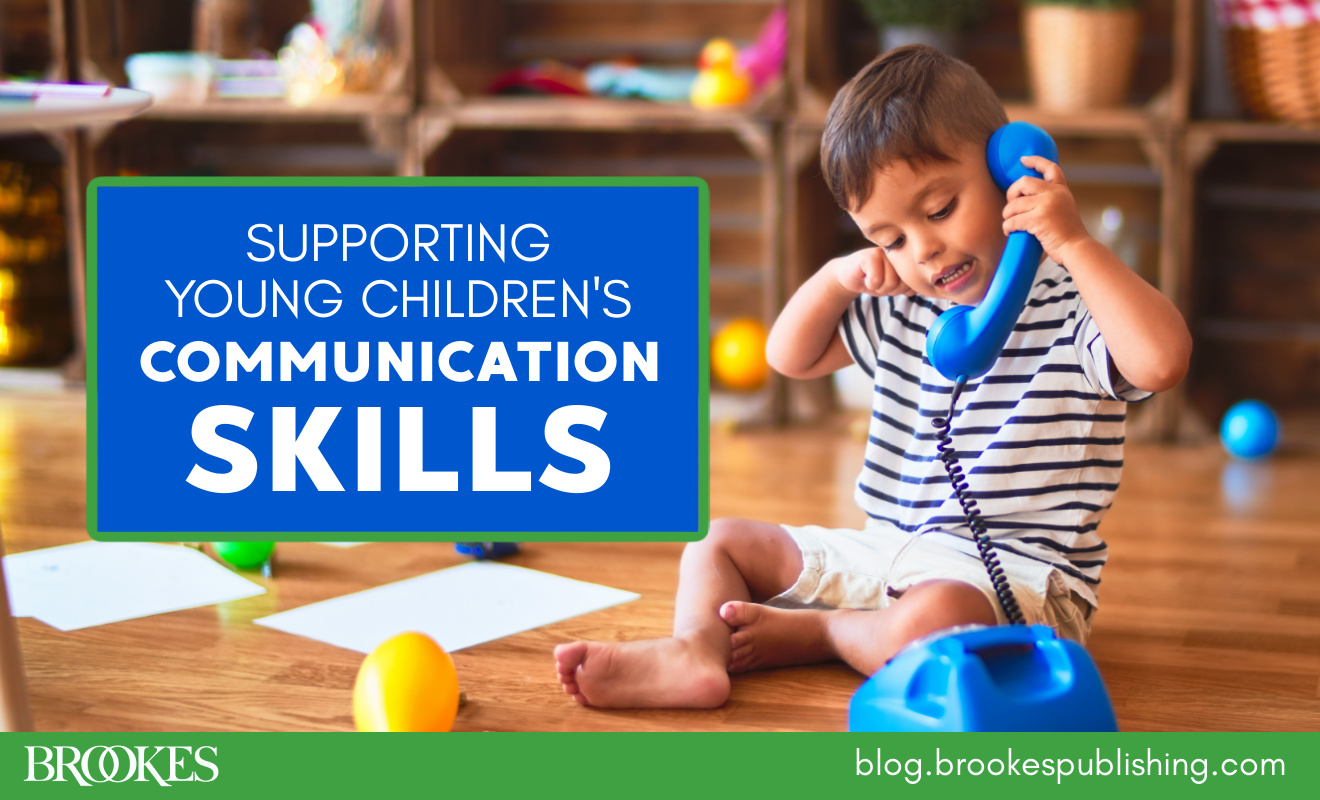
10 Easy Ways to Support a Young Child’s Communication Skills
Write a comment.
Your email address will not be published. Required fields are marked *
MULIANI BT ABU BAKAR says
I need an advice(s) the teaching strategies to kids with learning difficulties. Starting by teaching phonics , hoe else should I proceed. Fitzroy Readers are so far very effective. Tqvm
jlillis says
Hi! You can find our complete list of books related to teaching children with learning disabilities here: https://products.brookespublishing.com/Learning-Disabilities-C1059.aspx. Many of these have sections on teaching literacy skills, including writing, to students with learning difficulties.
Daisy Simpson says
Amazing article. All the 7 steps are just wonderful for students. I want to add one more method by which you can try to teach them writing skills. You can ask students to read some story of their choice and ask them to write the same story in their own words, it will help them to write on the beginning stage because they know the story and just need to write by themselves. Writing a story without reading can be difficult for students but if they have read the story can write it.
Thank you, Daisy! Great suggestion!
maheshsea says
Thanks for sharing the significant information. It helped my children and will help others a lot. Nice.. ...All the 7 steps are just wonderful for students
Basudeb Das says
Well explained
Andi Duferense says
Amazing article. All the 7 steps are just wonderful for students. I want to add one more method by which you can try to teach https://www.google.com/ writing skills. You can ask students to read some story of their choice and ask them to write the same story in their own words, it will help them to write on the beginning stage because they know the story and just need to write by themselves. Writing a story without reading can be difficult for students but if they have read the story can write it.
Post a Comment
Educating Special Needs Students Essay
Intellectual disabilities pose a great challenge to students, parents, and teachers alike. The effects of these disabilities vary from individual to individual and usually require intensive management. This partly arises from the wide range of differences in the types of intellectual disabilities, and differences in the range of impairment even among students suffering from the same type of intellectual disability.
This paper explores different types of disabilities and their impacts, to review the efficacy of policy initiatives meant to streamline the management of students with intellectual disabilities in the Sky View Elementary School District.
Definitions
This paper discusses the main types of intellectual impairments. These disabilities include intellectual disability, autism, severe disabilities, and multiple disabilities.
This section reviews the definitions of each of these conditions. According to the American Association on Intellectual and Developmental Disabilities (AAIDD), intellectual disability describes a condition characterized by “significant limitation in both intellectual functioning and adaptive behavior”.
The condition must be existent before the age of 18 for it to fit in this definition. The main causes of intellectual disability are genetic factors, malnutrition during pregnancy, birth trauma resulting in asphyxiation, and illness or injury leading to brain damage. They can occur before or after birth.
Autism covers a wide range of developmental impairments. Modern literature does not refer to autism as a single condition but as a spectrum. The autism spectrum reflects the varying severity of autism in autistic persons. Autism refers to a developmental disorder that generally inhibits the development of the skills needed in “communication and social interaction”. An autistic person may or may not have learning difficulties.
There is no consensus on the actual cause of autism. However, there is a growing body of evidence linking the occurrence of autism to genetic predisposition. However, the onset of the condition depends on environmental factors during pregnancy, during childbirth, and the initial days after birth.
Severe disabilities and multiple disabilities refer to a special category of impairments. Usually, people with severe disabilities require help in more than one area of their life to live normally. Severe disabilities usually include retarded mental development.
In the case of multiple disabilities, one person usually suffers from more than one disability. For instance, a person may experience mental retardation and a form of physical disability. In these cases, the person requires full-time care to live normally. Severe and multiple disabilities results from various causes. These causes include prenatal conditions, birth defects, accidents, infections, and exposure to toxins.
The impacts of intellectual disability, autism, and severe and multiple disabilities on education are very many. These impacts vary from case to case, and the degree of education possible depends on the severity of the underlying conditions. Some of the impacts of these disabilities on education are as follows. First, the students need full-time care in addition to specialized instructors.
This means that schools must use more resources to take care of special children. Secondly, schools need special equipment to take care of the special needs of these children. For instance, a teacher in a normal school may have the option of using chalkboards and projectors as teaching aids. In a special school, it may be difficult to use these facilities because of low attention spans among students.
The teacher must use an individualized approach to teach each student. Thirdly, special schools compete with normal schools for resources. Public schools have greater political power because of the huge number of students they handle. This makes it difficult for special schools to get additional resources to cater for the special needs of intellectually impaired students.
Areas of Curriculum Necessary for Students with Severe Disabilities
The areas of curriculum necessary for students with severe disabilities exceed those required for normal students. This arises from the fact that students with severe disabilities usually need more time and practice to master basic life skills.
By the time they attain school-going age, it is still common for them to require help with basic skills such as going to the bathroom. In this regard, their instructors must use a wider curriculum to help them to develop their skills.
The main areas of focus in the training of students with special needs are as follows. First, a student with severe disabilities needs training to master basic life skills. In this regard, basic life skills refer to activities such as eating, using the bathroom, dressing up, and even crossing roads. The severity of the impairment plays an important part in the decision to teach them these skills.
Secondly, the curriculum for students with severe disabilities should include communication skills. The teaching of communication skills must correlate to the ability of the student.
For instance, some autistic students can learn how to speak and can increase their vocabulary. Some cannot speak at all, and may only benefit from the use of sign language. In this case, the development of the teaching plan for each student must take into account the potential of the student.
The third aspect of the curriculum intended for students with severe disabilities must be the development of social skills. The main issue in this regard is that the failure to develop practical social skills can impair their ability to fit in society after school.
In any case, students with severe disabilities also need to know how to interact with their families, friends, and acquaintances as part of their daily lives. The challenge is greater for curriculum developers in cases where the students avoid contact with other people.
The fourth aspect that must form part of the curriculum for the training of students with severe disabilities is safety skills. Walking alongside a road is a completely mindless affair for a normal person, but may be life-threatening for a person with an impairment that hinders their ability to assess the danger posed by traffic.
For instance, if an autistic child notices that the road has continuous lines between lanes, the child may try to walk at the center of that road. Safety education can help to reduce or eliminate the dangers associated with such behavior.
The final area needed in special school curriculums is academic skills. Some students with severe impairment can learn how to read, write, and calculate. In this regard, the curriculums must support the development of intellectual skills up to the highest attainable level.
Special Education Policies in Sky View Elementary School District
The Sky View Elementary School District special education program has many positive traits and seems to compare well with the curriculum elements discussed in the previous section. The notable aspects of the special education program at Sky View are as follows.
First, the district has acknowledged the diversity that exists among students with severe disabilities. The district, therefore, offers students instruction based on the abilities of different students. For instance, the district has self-contained classrooms meant for a student with severe disabilities.
Students spend most of their time in school in these classrooms to improve their skills. This measure makes it possible to segregate students according to their skill level to concentrate on the range of skills they can learn.
Secondly, the district offers resource instruction to students in special schools. Resource instruction refers to the exposure of students to higher-level materials suited to specific learning capabilities. In this case, a student who has greater potential in certain areas receive instruction to develop their potential.
The third aspect of the instructional model used in the Sky View is that it gives parents and guardians a wide range of options regarding the choice of facilities for their children. The district has programs that allow for continual instruction for students who lose skills during breaks. Also, the district gives parents the option of full-time residency of their special children in faculties that offer full-time care.
The main problem associated with the management of the curriculum for special needs education in Sky View Elementary School District is the isolation of special children from normal children. There are very few points of contact between students in the special units and children in ordinary classrooms.
This can lead to maladjustment to society when students with severe disabilities leave the institution. At the same time, the students do not benefit from the opportunity to learn how to communicate and to socialize with unimpaired persons. This is one of the most important skills needed by severely impaired persons.
AAIDD. (2013). Definition of Intellectual Disability.
Dodd, S. (2005). Understanding Autism. New South Wales: Elsevier.
Downing, J. E., & MacFarland, S. (2008). Severe Disabilities (Education and Individuals with Severe Disabilities: Promising Practices). International Encyclopeadia of rehabilitation , 114-118.
Glenn, R. (2007). Bringing User Experience to Healthcare Improvement: The Concepts, Methods and Practices of Experience-based Design. Oxon: Radcliffe Publishing.
- Chicago (A-D)
- Chicago (N-B)
IvyPanda. (2022, August 1). Educating Special Needs Students. https://ivypanda.com/essays/educating-special-needs-students/
"Educating Special Needs Students." IvyPanda , 1 Aug. 2022, ivypanda.com/essays/educating-special-needs-students/.
IvyPanda . (2022) 'Educating Special Needs Students'. 1 August.
IvyPanda . 2022. "Educating Special Needs Students." August 1, 2022. https://ivypanda.com/essays/educating-special-needs-students/.
1. IvyPanda . "Educating Special Needs Students." August 1, 2022. https://ivypanda.com/essays/educating-special-needs-students/.
Bibliography
IvyPanda . "Educating Special Needs Students." August 1, 2022. https://ivypanda.com/essays/educating-special-needs-students/.
- Integrating Autistic Children Into Mainstream Classrooms
- "Emergence: Labeled Autistic" by Temple Grandin
- Inclusion Curriculum for Children With Autism
- Autistic Children Affecting Communication Skills of Siblings
- How Inclusion Impacts Autistic Children?
- Education Considerations for Students With Autism
- Saudi Arabian Education: Autistic Children' Inclusion
- Raising Autistic Children Effectively
- High Level Autistic Disorder
- Autistic Community: Media Representation
- Replacing School Notebooks by Notebook Laptop
- Education Issues: School Notebooks or Notebook Laptops
- Aligning English Language Learners Proficiency Standards
- Arizona's English Language Learner Legislation
- University of Miami Business Program
Teaching How to Write a Paragraph for Special Education Students
- Categories : Inclusion strategies for mainstreamed classrooms
- Tags : Special ed information for teachers & parents
Building a Winning Essay One Paragraph at a Time
A winning essay and a completed one begin with paragraph at a time. For students with special needs, the process must be detailed and sequential from beginning to end. Students must be provided with the right tools (computer, pens, pencils, dictionary, notebooks etc) to complete the assignment along with specifics on good paragraph construction that provides details and transitions from one paragraph to the next into a final essay.
Parts of a Paragraph
- Title: the title drives the content of the paragraph. For example if a student wants to talk about, “Building a Birdhouse,” then the title will drive the rest of the paragraph like the topic sentence, supporting facts and details and the conclusion. The title must be concrete enough that if a student wanted to research the topic, the keywords would drive the engine search for information on building birdhouses.
- Topic Sentence : the topic sentence begins the paragraph by stating what the paragraph is about in content and context. For example, using the title, “Building a Birdhouse,” the topic sentence might be, “Building birdhouses are eco-friendly for the birds and for the builders.” The topic sentence will then drive the rest of the paragraph by answering the questions, “Why, Provide Details, Show Examples, and Provide Pictures of Built Birdhouses.”
- Details and Supporting Facts and Examples: details are important in showing the writer’s expertise as the builder of birdhouses or as the great researcher of articles on how to build birdhouses. If the building is first hand experience, then the writer can use “I” in “When I build birdhouses with my dad, we build them together as a team.” The details could then be, “I select the type of wood that will be used to build a birdhouse. I also select the paint colors of yellow and red to attract the birds to my families outdoor bird sanctuary.” Students should be encouraged to take pictures of their birdhouses and include them in their essay, especially in the first paragraph for a dramatic and personalized essay experience.
- Conclusion: in the closing sentence of the paragraph, the sentence is basically a topic sentence wrap-up using different words to convey a sense of closure to the the contents of the paragraph. Each paragraph has a conclusion that allows the writer the ability to transition to another paragraph building upon the first until the essay is fully completed.
- Final Essay : the final essay consisting of three paragraphs or 23 paragraphs (spellchecked) will have a title page with the title, writer’s name, teacher’s name, course and the date and pages containing content. Each page is numbered and each paragraph is double spaced for easy reading and editing.
Teachers can provide the learning objective, supplies (dictionary, thesaurus, writing software if needed for students needing assistive software per IEPs, and monitoring to guide students in writing their essay beginning with the first paragraph to the last one. When given the right tools and support, any student can build a winning essay, one paragraph a time.
Home — Essay Samples — Education — Educational System — Special Education
Essays on Special Education
School uniform persuasive speech, case study honig v doe, made-to-order essay as fast as you need it.
Each essay is customized to cater to your unique preferences
+ experts online
Reflection on Special Needs
An analysis applying the 10-step special education process, the history of the creation of special education in america, whether all, some or no children with special educational needs should be included and educated in mainstream schools, let us write you an essay from scratch.
- 450+ experts on 30 subjects ready to help
- Custom essay delivered in as few as 3 hours
The Individuals with Disabilities Education Act (idea)
Disabled students and their access to education, individualized education plans (iep), inclusive education implementation, get a personalized essay in under 3 hours.
Expert-written essays crafted with your exact needs in mind
Safeguarding: Bespoke Vs Off-the-shelf Courses
American with disabilities act, my aspiration to pursue a career in education, adventure and experiential education: principles, adaptations and a case study, naïve concepts, the under-representation of children of colour within special education, features of teaching english to students with disabilities, specialized area of higher education, overview of an academic writing, global citizenship education and water pollution, exploring homeschooling as an alternative to public education, reaction paper on "what’s so great about a jesuit education", inclusion of special education students in classroom: an overview, importance of inclusive education in the modern world, relevant topics.
- Middle School
- High School
- Single Sex Schools
- Extracurricular Activities
- Homeschooling
- Online Vs. Traditional Classes
- Health Education
By clicking “Check Writers’ Offers”, you agree to our terms of service and privacy policy . We’ll occasionally send you promo and account related email
No need to pay just yet!
We use cookies to personalyze your web-site experience. By continuing we’ll assume you board with our cookie policy .
- Instructions Followed To The Letter
- Deadlines Met At Every Stage
- Unique And Plagiarism Free
The Hechinger Report
Covering Innovation & Inequality in Education

OPINION: Artificial intelligence can be game-changing for students with special needs
Share this:
- Click to share on LinkedIn (Opens in new window)
- Click to share on Pinterest (Opens in new window)
- Click to share on Reddit (Opens in new window)
- Click to share on WhatsApp (Opens in new window)
- Click to email a link to a friend (Opens in new window)
The Hechinger Report is a national nonprofit newsroom that reports on one topic: education. Sign up for our weekly newsletters to get stories like this delivered directly to your inbox. Consider supporting our stories and becoming a member today.
Get important education news and analysis delivered straight to your inbox
- Weekly Update
- Future of Learning
- Higher Education
- Early Childhood
- Proof Points
Much has been made of artificial intelligence’s potential to revolutionize education. AI is making it increasingly possible to break down barriers so that no student is ever left behind.
This potential is real, but only if we are ensuring that all learners benefit.
Far too many students, especially those with special needs, do not progress as well as their peers do academically. Meanwhile, digital media, heavily reliant on visuals and text, with audio often secondary, is playing an increasing role in education.
For a typical user in most cases, this is fine. But not for blind or deaf students, whose sensory limitations frequently impede their access to quality education. The stakes are much higher for these students, and digital media often underserves them.
That’s why the development of AI-powered tools that can accommodate all learners must be a priority for policymakers, districts and the education technology industry.
Related: ‘We’re going to have to be a little more nimble’: How school districts are responding to AI
Good instruction is not a one-way street where students simply absorb information passively. For learning content to be most effective, the student must be able to interact with it. But doing so can be especially challenging for students with special needs working with traditional digital interfaces.
A mouse, trackpad, keyboard or even a touch screen may not always be appropriate for a student’s sensory or developmental capabilities. AI-driven tools can enable more students to interact in ways that are natural and accessible for them.
For blind and low-vision students
For blind and low-vision students, digital classroom materials have historically been difficult to use independently. Digital media is visual, and to broaden access, developers usually have to manually code descriptive information into every interface.
These technologies also often impose a rigid information hierarchy that the user must tab through with keys or gestures. The result is a landscape of digital experiences that blind and low-vision students either cannot access at all or experience in a form that lacks the richness of the original.
For these students, AI-powered computer vision offers a solution — it can scan documents, scenes and apps and then describe visual elements aloud through speech synthesis. Coupled with speech recognition, this allows seamless conversational navigation without rigid menus or keyboard commands.
Free tools like Ask Envision and Be My Eyes demonstrate this potential. Using just an AI-enabled camera and microphone, these apps can capture and explain anything the user points them toward, and then answer follow-up questions.
These technologies have the potential to allow blind and low-vision students to get the full benefit of the same engaging, personalized ed tech experiences that their peers have been using for years.
For deaf and hard-of-hearing students
In some ways, the visually oriented world of digital media is an ideal fit for deaf and hard-of-hearing students. Audio is often a secondary consideration; particularly once users can read.
In cases in which audio is required for comprehension, like with video, the accommodation most digital developers provide is text-based captioning. Unfortunately, this means that a user must already be a proficient reader.
For younger learners, or any learner who does not read fluently or quickly, translation into sign language is a preferable solution. AI can be of service here, translating speech and text into animated signs while computer vision reads the user’s gestures and translates them into text or commands.
There are some early developments in this area, but more work is needed to create a fully sign language-enabled solution.
For the youngest learners
For young learners, even those without diagnosed disabilities, developmentally appropriate interactions with conventional desktop/mobile apps remain a challenge. A young child cannot read or write, which makes most text-based interfaces impossible for them. And their fine motor control is not fully developed, which makes using a mouse or keyboard or trackpad more difficult.
AI voice controls address these problems by enabling students to simply speak requests or responses, a more natural interaction for these pre-readers and -writers. Allowing a child to simply ask for what they want and verbally answer questions gives them a more active role in their learning.
Voice control may also enable a more reliable assessment of their knowledge, as there are fewer confounding variables when the student is not trying to translate what they understand into an input that a computer will understand.
Computer vision can smooth over text-based methods of interaction. For example, username/password login forms can be replaced with QR codes; many school-oriented systems have already done so.
Computer vision can also be used to enable interactions between the physical and digital world. A student can complete a task by writing or drawing on paper or constructing something from objects, and a computer can “see” and interpret their work.
Using physical objects can be more developmentally appropriate for teaching certain concepts. For example, having a child count with actual objects is often better than using digital representations. Traditional methods can also be more accurate in some cases, such as practicing handwriting with pencil and paper instead of a mouse or trackpad.
Even without physical objects, computer vision can enable the assessment of kinesthetic learning, like calculating on fingers or clapping to indicate syllables in a word.
Related : STUDENT VOICE: Teachers assign us work that relies on rote memorization, then tell us not to use artificial intelligence
A major hurdle in education is that although every student is unique, we have not had the tools or resources to truly tailor their learning to their individualized strengths and needs. AI technology has the potential for transformative change.
The responsibility falls on all of us — districts, policymakers and the ed tech industry — to collaborate and ensure that AI-powered accessibility becomes the norm, not the exception.
We must share knowledge and urgently advocate for policies that prioritize and fund the swift deployment of these game-changing tools to all learners. Accessibility can’t be an afterthought; it must be a top priority baked into every program, policy and initiative.
Only through concerted efforts can we bring the full potential of accessible AI to every classroom.
Diana Hughes is the vice president of Product Innovation and AI at Age of Learning .
This story about AI and special needs students was produced by The Hechinger Report , a nonprofit, independent news organization focused on inequality and innovation in education . Sign up for Hechinger’s newsletter .
Related articles
The Hechinger Report provides in-depth, fact-based, unbiased reporting on education that is free to all readers. But that doesn't mean it's free to produce. Our work keeps educators and the public informed about pressing issues at schools and on campuses throughout the country. We tell the whole story, even when the details are inconvenient. Help us keep doing that.
Join us today.
Letters to the Editor
At The Hechinger Report, we publish thoughtful letters from readers that contribute to the ongoing discussion about the education topics we cover. Please read our guidelines for more information. We will not consider letters that do not contain a full name and valid email address. You may submit news tips or ideas here without a full name, but not letters.
By submitting your name, you grant us permission to publish it with your letter. We will never publish your email address. You must fill out all fields to submit a letter.
Your email address will not be published. Required fields are marked *
Save my name, email, and website in this browser for the next time I comment.
Sign me up for the newsletter!
$2,000 No Essay Scholarship
Help cover the cost of college without writing a single essay!
Niche is giving one student $2,000 to put toward tuition, housing, books or other college expenses — no essay required.
Apply below for your chance to win so you can focus on your education, not your finances. Good luck!
Min 7 characters
By proceeding you acknowledge and agree to our Privacy Policy and Terms of Use .
By proceeding you acknowledge and agree to our Privacy Policy and Terms of Use and Scholarship Rules .
Who Can Apply
All high school and college students, as well as anyone looking to attend college or graduate school in the next year. Please note: Not everyone is eligible for this scholarship. Niche sponsored scholarships and sweepstakes are for people with US citizenship or a valid Visa/US passport only. Read the scholarship rules for full eligibility requirements.
How It Works
The $2,000 “No Essay” Scholarship is an easy scholarship with no essay required! Only one entry allowed per person. The winner will be determined by random drawing and then contacted directly and announced in Niche's email newsletter and on the Scholarship Winners page.
About Niche scholarships
We believe cost shouldn’t keep anyone from pursuing a higher education, so we connect students with thousands of scholarships — many of which don’t require an essay — to help them afford college. In 2023 alone, we offered over $285,000 in Niche scholarships. Read more about Niche scholarships here or visit our FAQs .
- Share full article
Advertisement
Supported by
Students in a Moscow School Debate the Once-Undebatable
By Philip Taubman, Special To the New York Times
- Oct. 20, 1988
For years the study of Soviet history at Secondary School 831 in Moscow was less an exercise in understanding the country's heritage than in denying it.
Yevdokiya Syto, a teacher, had relatives who were expelled from the Communist Party and imprisoned, but the history curriculum did not allow her to tell students about the great terror that swept the country in the 1930's.
Maksim Pechnikov, now in his last year of high school, was told by his parents about family members who were thrown out of the party and executed by firing squad under Stalin, but he dared not mention the cases to his classmates.
The history textbooks long used at the school treated the 1930's as a time of economic achievement, making no mention of the famine and purges that killed millions.
All that is changing now. With the encouragement of Mikhail S. Gorbachev, the Soviet leader, School 831 and thousands of others across the country have set aside old textbooks and fears and are openly confronting a turbulent past that teachers and students knew existed but could barely acknowledge in the classroom.
The students still dress in navy blue school uniforms, and classrooms are still adorned with posters extolling the virtues of Communism, but the intellectual atmosphere - in topics ranging from history to economics to capitalism - is bubbling with curiosity and candor.
''The things my grandmother once told me in whispers - about her brother who was sent to prison, another who was executed - we can now talk about at school,'' Mr. Pechnikov said.
''The atmosphere is entirely different,'' he added.
The absence of a single, officially approved version of history forced the cancellation last spring of written history exams for 10th-form students like Mr. Pechnikov, the equivalent of American high school seniors. No decision has been made yet on whether to resume written exams at the end of the current school year.
As with many of the other changes initiated by Mr. Gorbachev, the remaking of high school history courses has not been easy and is far from complete. It was clear during a recent visit to School 831, a spartan, three-story concrete building in northern Moscow, that the evolution of the curriculum has produced unusual spontaneity and uncertainty in the classroom.
Teachers at the school, which in American terms covers grades 3 through 12, have substituted current journals, magazines and newspapers for the outdated, circumscribed textbooks that were for decades the bibles of high school history classes.
Andrei Y. Kulakov, a history teacher, shook his head when a visitor asked about the books. ''They are almost useless,'' he said.
The choice of reading material, Mr. Kulakov said, is his alone, a startling departure from the traditional system in which every source of information was screened and sanitized by the authorities. Shortcomings Discussed
During a discussion with 10th form students about economic differences between Communism and capitalism, Mr. Kulakov encouraged a spirited debate about the benefits of each system, and several students talked openly about shortcomings in the Soviet system. There was little sign of the rote learning that has long dominated Soviet education.
When Mr. Kulakov raised the issue of how manufactured goods are valued, the dozen or so students in his corner classroom, paired off two to a desk, consulted among themselves for a few moments, and then hands shot up.
''Many Soviet enterprises work on obsolete equipment,'' one student said. ''That means many of the goods are costly to produce, but because their quality is low, their utility value is essentially zero because no one wants to buy them.''
Unfazed, Mr. Kulakov replied, ''You're right, and such a situation can be viewed as a burden on society.'' A Sense of Liberation
Mr. Kulakov, whose enthusiasm and willingness to tackle controversial material apparently made him something of a maverick at the school, reported a sense of liberation among some of his colleagues as curriculum controls have eased.
''It's possible to be honest now in a way it was not even two or three years ago,'' he said.
For Mrs. Syto, an energetic woman who has been teaching history for more than two decades, the expanding boundaries of discussion have lifted a veil that separated her personal and professional lives.
''I lived in that time,'' she said of the 1930's. ''So much is in my memory, so many people in my family suffered, but there was little I could say in class. I mentioned some things, but we could not go into much detail.'' Stalin 'Not a Simple Figure'
Students, freed from the rigid constraints of earlier years, have discovered differences of opinion.
''Stalin is not a simple figure to analyze,'' said Irina Prytkova, a 10th form student. Like most of her classmates, she is 16 years old.
''His brutality and assertion of the cult of personality were reprehensible, but he has also a genius. Look at the way he handled the postwar conference at Potsdam.''
Maksim Pechnikov, her classmate, reddened as Miss Prytkova talked. ''I can't agree,'' he interrupted. ''How can you call a man great who was a sadist?'' he asked. 'Up to His Elbows in Blood'
Yevgeny Leizarovich, another classmate, interjected: ''Don't forget his treatment of Bukharin and the destruction of other Communists. He was up to his elbows in blood.''
Miss Prytkova, who said she wants to be a lawyer, defended her position. ''You may not like everything he did,'' she said, ''but Stalin made certain there was discipline. Some of the measures he used - insisting on tough control against fraud and embezzlement - some of these policies would be useful today.''
Mr. Pechnikov, who hopes to make a career in the military, said: ''But Ira, all those controls were based on sheer terror. It was not rational.''
When Miss Prytkova suggested that at least Stalin was a great war leader, her classmates looked livid.
''He practically destroyed the officer corps during the purges,'' Mr. Pechnikov said. Startled by Reactions
Somewhat startled by the vehement reactions, Miss Prytkova made a tactical retreat.
''I know,'' she said, ''that no matter how great a genius Stalin was, he can never atone for his crimes before the Soviet people.''
When asked by an American visitor whether they were changing their view of other historical figures, including Trotsky, long depicted as the archvillain of the revolution, Mr. Pechnikov said: ''Trotsky was portrayed strictly as a negative figure. Anything about his contributions was omitted. I think we need a more balanced view.''
How much of the current openness will be reflected in the new textbooks is unclear. Mr. Kulakov questioned whether credible new textbooks could be written by the historians who prepared the last ones.
A few days after Mr. Kulakov expressed his doubts, Mr. Gorbachev, addressing a commission that is preparing a new history of the Communist Party, offered some advice that echoed the changed atmosphere at School 831.
The new history, he said, must ''give an honest and frank analysis of the causes of deformations, and thoroughly investigate why the emergence and growth of authoritarian bureaucratic distortions and their consequences were not prevented.''
- Bahasa Indonesia
- Slovenščina
- Science & Tech
- Russian Kitchen
Moscow makes the case for school reform
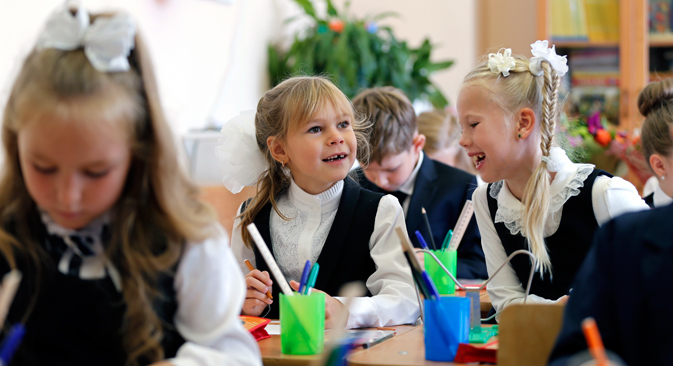
Russia instigated a major reform of its educational system in 2010 to improve administration and quality. Source: EPA/Vostok Photo
When news came in fall 2012 that School 122 in central Moscow would be merged with another school, parents were up in arms. The school, which is the home of the Moscow Boys Cappella and requires all students to take choir, is one of the few places outside of conservatories where students can do coursework for a special diploma in music. Parents were afraid that the merger would not only result in the loss of the special music curriculum, but that it would “destroy the school’s unique culture,” in the words of one parent, whose daughter was then in the second grade.
The school was slated for consolidation under a controversial reform that began in 2010 and involves merging small or underperforming schools with larger schools primarily to more evenly distribute financial and administrative resources. Under the reform, funding for schools would be distributed on a per capita basis — a move officials said was necessary to accommodate an increase in demand.
“In our very large country, it is essential to ensure maximum equal access to early childhood services, and supplementary education,” said Prime Minister Dmitry Medvedev, defending the changes, which went into effect Jan. 1, 2011.
Russia experienced a baby boomlet during the economic prosperity of the early 2000s. Russia’s state statistics service, Rosstat, showed a steady increase in births from 2007–2012. In Moscow, 101,000 children were born in 2007. By 2012, that number had risen to more than 134,000. While some schools in the center of Moscow, like School 122, are undersubscribed, schools in the bedroom communities on the edges of the city, where young families moved into newly constructed apartment complexes, are overcrowded.
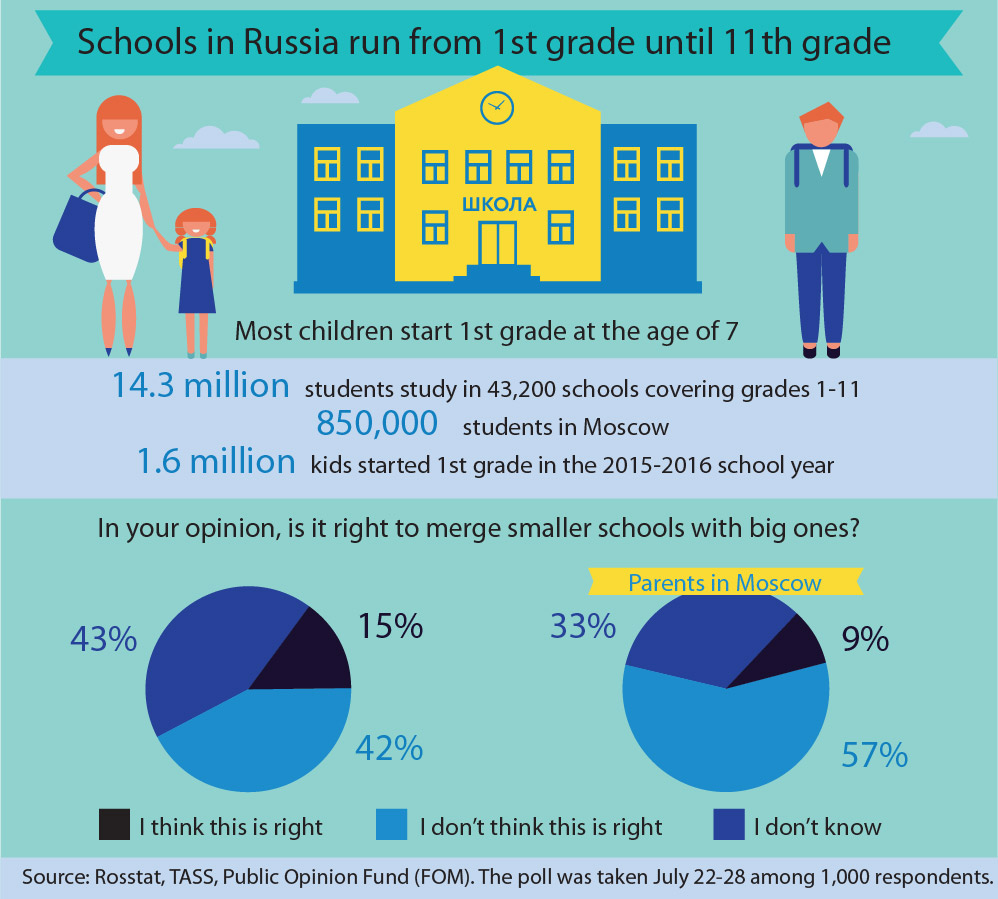
Click to view the infographics
Parents at Intellectual, a state-run boarding school for gifted students in western Moscow, took to the streets to protest the merger and expansion of their school, which had a student-teacher ratio of two to one. Students from the school took up the cause, writing letters to President Vladimir Putin and Moscow’s mayor and making a short film that was shown on local news portal Moskva24.
Moscow Deputy Mayor Leonid Pechatnikov responded in an interview with Russian daily Kommersant that if the parents wanted to keep that level of staffing, they would have to pay for additional salaries themselves. “We cannot afford to allocate 378,000 rubles ($5,640) per student. Two students for one teacher is, in fact, a system of tutoring. We have a law on universal education, but we do not have the law on universal tutoring,” Pechatnikov said.
The average amount per student spent in Moscow schools today is 63,000 rubles ($940).
In search of excellence
In addition to redistributing funding, the reform’s authors hoped to improve the performance of students on the Unified State Exam (E.G.E.), which is required for graduation from Russian schools, by combining schools with weaker academics with stronger ones.
Boris Kagarlitsky, a political scientist and the director of the Institute of Globalization and Social Movements, said that this second goal is at odds with the first one.
“In Soviet times, they sought to reduce class sizes so that the teacher could work with each student. Now per capita funding encourages schools to fill classrooms as much as possible, with fewer teachers,” Kagarlitsky said.
But other experts disagree with Kagarlitsky. Isak Frumin, a researcher at the Institute of Education of the Higher School of Economics in Moscow, said that forcing smaller schools to merge with larger ones will give more students access to high-quality education.
“There are several schools where the competition was dozens of people for one place, but now they were given additional space by combining with other schools and now they take more children. Opportunities to send a child to a good school have increased,” Frumin said.
Writing in a blog on the website of independent radio station Ekho Moskvy, local lawmaker Irina Kurash said that it is clear that the school reform has been a success — parents no longer have to “run around Moscow” in search of a good school and teacher salaries have increased as administrative costs were lowered, she wrote. Additionally, she noted, 13 schools in Moscow made it into the listing of the top 25 schools in Russia.
“Moscow finally has a fair system of financing educational institutions. Now funding decisions are based on standards and not the status of the school,” Kurash wrote. Previously school funding depended in part on the school’s designation, if it was classified as an ordinary school or had a title that indicated a special curriculum, such as “gymnasium.”
Out of options
Frumin said that no matter what experts and parents think of the reforms, they are necessary. This year, the number of children entering school in Russia has increased by 560,000 over last year, and the number is only going to continue to rise at least for the near future.
“In the next few years, we will need between 1 and 2 million new places,” Frumin said. “Either the number of children who will study in a second shift will increase, or we should put new school buildings into operation. This is a serious problem for the entire country; we are talking about hundreds of billions of rubles. The money has not been fully allocated for it.”
Over the past four years, 4,000 schools in Moscow have been combined into 692 larger institutions — including Intellectual, which merged with Gymnasium 1588, and School 122, which was united along with a kindergarten and a school with an intensive German-language program, with School 1234, an English-intensive school with a reputation for strong academics.
After the merger, the students remained in the same building and the music curriculum continued, but School 1234 brought in a new administration and some new teaching staff in the academic subjects in the upper school. The crumbling entryway and concert hall of the school’s 1930s building were remodeled and a new playground was installed. Now, two years later, the graduates of combined School 1234 scored so well on the E.G.E. that the school is now ranked 57th out of all schools in Moscow. After years of struggling to attract new students, the arts division introduced a first-grade class of 21 students at the opening bell ceremony on Sept. 1 and the school choirs held a concert as part of Moscow’s official City Day celebrations on Sept. 5.
“Things have changed for the better, and many of our fears were not realized,” said one parent with two children at the school, who declined to give his name.
According to a poll conducted by the Public Opinion Foundation (FOM) in July , his views are shared by only 15 percent of parents; 42 percent of Russian parents believe the consolidation of schools is wrong. But for nearly half of those who responded, the jury is still out — 43 percent of respondents told the pollsters the question was too difficult to answer.
.jpg)
All rights reserved by Rossiyskaya Gazeta.
to our newsletter!
Get the week's best stories straight to your inbox
This website uses cookies. Click here to find out more.

IMAGES
VIDEO
COMMENTS
For example, Wong, Butler, Ficzere, and Kuperis (1996), in teaching students to write opinion essays, used peer editing as an instructional strategy for the students. Pairs of students alternated their roles as student-writer and student-critic. The student-critic identified ambiguities in the essay and asked the writer for clarification.
This post is part of the series: The Five Step Writing Process for Students with Special Needs. The 5 steps to good writing include: 1) Pre-writing (Brainstorming), 2) Writing (Content), 3) Rewriting/Revising, 4) Editing/Proofreading, 5) Publishing. This series goes through each step, outlining some ideas to try for students who struggle.
Five-paragraph essay conclusions are often difficult to write, especially for struggling writers. Some special education teacher challenges are students who want to repeat exactly what they already wrote, or they say they are stuck and have no idea what to write. This modified lesson plan takes students' step-by-step through the five-paragraph essay conclusion and provides an example.
Teaching persuasive writing for special ed students can include scaffolding details from the title to the conclusion. In this article, modifying the persuasive essay for students with learning disabilities can provide a welcome relief to students who enjoy writing, but who aren't sure how to construct their writing.
For example, Wong, Butler, Ficzere, and Kuperis (1996), in teaching students to write opinion essays, used peer editing as an instructional strategy for the students. Pairs of students alternated their roles as student-writer and student-critic. The student-critic identified ambiguities in the essay and asked the writer for clarification.
The ability to write a paragraph is a specific skill that lays the foundation for more advanced writing; however, special education students may have a difficult time writing paragraphs for a ...
The achievement of students with special needs is a critical issue for all schools and teachers. Writing effectively is one of the areas in which students struggle most and in which classroom teachers struggle most to support them. This is the first in a four part series chronicling my efforts at teaching writing to students.
Writing in the Special Education classroom. Students in the education classrooms write essays, research articles, policy papers, and teaching assessments. A variety of writing styles is required. These skills transfer outside of the university experience for teachers as they assess their students, write articles for school news, correspond with ...
This issue of The Practical Teacher provides an integrated approach to classroom writing instruction designed to accommodate the special needs of disabled writers, as well as those of their non-disabled peers. NASET Members may access this Practical Teacher by Logging in (see Login area to the right). Visitors can access a sample issue by ...
11 Writing Activities Your Special Needs Students Will Enjoy #1 Comic Book Writing. I have found that some of my students love writing comic book stories. They don't feel overwhelmed like they do when they are assigned a five-paragraph essay. In addition, it is a creative way to practice writing in smaller sentences.
In this essay, I will discuss and review information on inclusion of special education students and the issues that individuals with disabilities encounter as they progress into adulthood. According to Salend, 2005, 'inclusion is a philosophy that brings diverse students, families, educators, and community members together to create schools and ...
Writing time for a special education student can be less than productive - and extremely frustrating. Just putting their name on the paper can often be considered an achievement for an LD student or one who has difficulty attending to the task at hand.As teachers, we differentiate instruction across content areas for special needs students.
Check our 100% free special education essay, research paper examples. Find inspiration and ideas Best topics Daily updates ... We will write a custom essay specifically for you for only 11.00 9.35/page. 808 certified writers online. ... Two articles under consideration consider the opposite views regarding the education of students with autism ...
Computer-assisted instruction. Show the student a word/picture combination, and then ask him to select letters from a computer-based array to construct the word shown. Cover, copy, compare (CCC) technique. Give the student a piece of paper divided into four columns. The first column contains the targeted spelling word.
Get custom essay. The main areas of focus in the training of students with special needs are as follows. First, a student with severe disabilities needs training to master basic life skills. In this regard, basic life skills refer to activities such as eating, using the bathroom, dressing up, and even crossing roads.
Special Education According to the Federal Laws of the United States of America, "Special Education means specially designed instruction, at no cost to the parents, to meet the unique needs of a child with a disability [IDEA 97-300.26(a)]." The revised statutes of Arizona defines a child with disability as "a child who is at least three but less than twenty-two years of age, who has been ...
Final Essay: the final essay consisting of three paragraphs or 23 paragraphs (spellchecked) will have a title page with the title, writer's name, teacher's name, course and the date and pages containing content. Each page is numbered and each paragraph is double spaced for easy reading and editing. Teachers can provide the learning ...
Write my essay. 7 Individualized Education Plans (iep) ... Introduction In this essay, I will discuss and review information on inclusion of special education students and the issues that individuals with disabilities encounter as they progress into adulthood. According to Salend, 2005, 'inclusion is a philosophy that brings diverse students ...
Effective writing is a vital component of students' literacy achievement, and writing is a critical communication tool for students to convey thoughts and opinions, describe ideas and events, and analyze information. Indeed, writing is a life-long skill that plays a key role in post-secondary success across academic and vocational disciplines.1
Analytical Survey of information and communication technology in special education Executive Summary Promotion of education is a fundamental objective of UNESCO. By definition, people with disabilities are often restricted in the extent to which they can take a full part in the society in which they live, but many of those restrictions can be ...
The development of AI-powered tools that can break down barriers to digital learning for special needs students must be a priority for policymakers, districts and the education technology industry. ... A student can complete a task by writing or drawing on paper or constructing something from objects, and a computer can "see" and interpret ...
A new tool called Writable, which uses ChatGPT to help grade student writing assignments, is being offered widely to teachers in grades 3-12.. Why it matters: Teachers have quietly used ChatGPT to grade papers since it first came out — but now schools are sanctioning and encouraging its use. Driving the news: Writable, which is billed as a time-saving tool for teachers, was purchased last ...
as students' capacity to intervene in their higher education environment for the purposes of achieving self-formation and well-being which I see as two of the fundamental purposes of higher education. Studentship, being a student, is namely, a rite of passage to some new role, status or life condition. It is
March 31, 2024. Help cover the cost of college without writing a single essay! Niche is giving one student $2,000 to put toward tuition, housing, books or other college expenses — no essay required. Apply below for your chance to win so you can focus on your education, not your finances. Good luck!
Teachers at the school, which in American terms covers grades 3 through 12, have substituted current journals, magazines and newspapers for the outdated, circumscribed textbooks that were for ...
Students from the school took up the cause, writing letters to President Vladimir Putin and Moscow's mayor and making a short film that was shown on local news portal Moskva24.